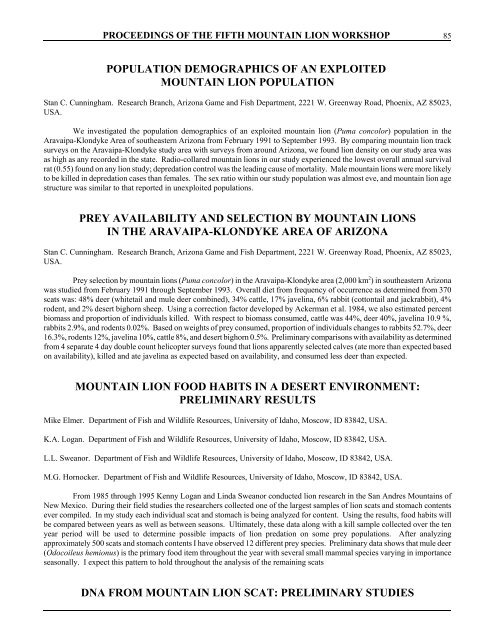Proceedings of the fifth mountain lion workshop: 27
Proceedings of the fifth mountain lion workshop: 27
Proceedings of the fifth mountain lion workshop: 27
You also want an ePaper? Increase the reach of your titles
YUMPU automatically turns print PDFs into web optimized ePapers that Google loves.
PROCEEDINGS OF THE FIFTH MOUNTAIN LION WORKSHOP 85<br />
POPULATION DEMOGRAPHICS OF AN EXPLOITED<br />
MOUNTAIN LION POPULATION<br />
Stan C. Cunningham. Research Branch, Arizona Game and Fish Department, 2221 W. Greenway Road, Phoenix, AZ 85023,<br />
USA.<br />
We investigated <strong>the</strong> population demographics <strong>of</strong> an exploited <strong>mountain</strong> <strong>lion</strong> (Puma concolor) population in <strong>the</strong><br />
Aravaipa-Klondyke Area <strong>of</strong> sou<strong>the</strong>astern Arizona from February 1991 to September 1993. By comparing <strong>mountain</strong> <strong>lion</strong> track<br />
surveys on <strong>the</strong> Aravaipa-Klondyke study area with surveys from around Arizona, we found <strong>lion</strong> density on our study area was<br />
as high as any recorded in <strong>the</strong> state. Radio-collared <strong>mountain</strong> <strong>lion</strong>s in our study experienced <strong>the</strong> lowest overall annual survival<br />
rat (0.55) found on any <strong>lion</strong> study; depredation control was <strong>the</strong> leading cause <strong>of</strong> mortality. Male <strong>mountain</strong> <strong>lion</strong>s were more likely<br />
to be killed in depredation cases than females. The sex ratio within our study population was almost eve, and <strong>mountain</strong> <strong>lion</strong> age<br />
structure was similar to that reported in unexploited populations.<br />
PREY AVAILABILITY AND SELECTION BY MOUNTAIN LIONS<br />
IN THE ARAVAIPA-KLONDYKE AREA OF ARIZONA<br />
Stan C. Cunningham. Research Branch, Arizona Game and Fish Department, 2221 W. Greenway Road, Phoenix, AZ 85023,<br />
USA.<br />
Prey selection by <strong>mountain</strong> <strong>lion</strong>s (Puma concolor) in <strong>the</strong> Aravaipa-Klondyke area (2,000 km 2 ) in sou<strong>the</strong>astern Arizona<br />
was studied from February 1991 through September 1993. Overall diet from frequency <strong>of</strong> occurrence as determined from 370<br />
scats was: 48% deer (whitetail and mule deer combined), 34% cattle, 17% javelina, 6% rabbit (cottontail and jackrabbit), 4%<br />
rodent, and 2% desert bighorn sheep. Using a correction factor developed by Ackerman et al. 1984, we also estimated percent<br />
biomass and proportion <strong>of</strong> individuals killed. With respect to biomass consumed, cattle was 44%, deer 40%, javelina 10.9 %,<br />
rabbits 2.9%, and rodents 0.02%. Based on weights <strong>of</strong> prey consumed, proportion <strong>of</strong> individuals changes to rabbits 52.7%, deer<br />
16.3%, rodents 12%, javelina 10%, cattle 8%, and desert bighorn 0.5%. Preliminary comparisons with availability as determined<br />
from 4 separate 4 day double count helicopter surveys found that <strong>lion</strong>s apparently selected calves (ate more than expected based<br />
on availability), killed and ate javelina as expected based on availability, and consumed less deer than expected.<br />
MOUNTAIN LION FOOD HABITS IN A DESERT ENVIRONMENT:<br />
PRELIMINARY RESULTS<br />
Mike Elmer. Department <strong>of</strong> Fish and Wildlife Resources, University <strong>of</strong> Idaho, Moscow, ID 83842, USA.<br />
K.A. Logan. Department <strong>of</strong> Fish and Wildlife Resources, University <strong>of</strong> Idaho, Moscow, ID 83842, USA.<br />
L.L. Sweanor. Department <strong>of</strong> Fish and Wildlife Resources, University <strong>of</strong> Idaho, Moscow, ID 83842, USA.<br />
M.G. Hornocker. Department <strong>of</strong> Fish and Wildlife Resources, University <strong>of</strong> Idaho, Moscow, ID 83842, USA.<br />
From 1985 through 1995 Kenny Logan and Linda Sweanor conducted <strong>lion</strong> research in <strong>the</strong> San Andres Mountains <strong>of</strong><br />
New Mexico. During <strong>the</strong>ir field studies <strong>the</strong> researchers collected one <strong>of</strong> <strong>the</strong> largest samples <strong>of</strong> <strong>lion</strong> scats and stomach contents<br />
ever compiled. In my study each individual scat and stomach is being analyzed for content. Using <strong>the</strong> results, food habits will<br />
be compared between years as well as between seasons. Ultimately, <strong>the</strong>se data along with a kill sample collected over <strong>the</strong> ten<br />
year period will be used to determine possible impacts <strong>of</strong> <strong>lion</strong> predation on some prey populations. After analyzing<br />
approximately 500 scats and stomach contents I have observed 12 different prey species. Preliminary data shows that mule deer<br />
(Odocoileus hemionus) is <strong>the</strong> primary food item throughout <strong>the</strong> year with several small mammal species varying in importance<br />
seasonally. I expect this pattern to hold throughout <strong>the</strong> analysis <strong>of</strong> <strong>the</strong> remaining scats<br />
DNA FROM MOUNTAIN LION SCAT: PRELIMINARY STUDIES

















